From July 11 to August 3, the AI art exhibition “MACHINE-MADE AURA” was held. Amid the rapid generalization of production methods that incorporate AI into the creative process, this exhibition explores what forms of creativity are nurtured through the interaction between machines and humans, questioning the nature of this co-creation. Just as sophisticated tools are treated as extensions of the human body, the fusion of human-made art and AI-generated works occurs in a way that is almost indistinguishable. This exhibition focuses on artists who naturally navigate between AI-generated works and analog expression methods such as hand-drawing and collage. It aims to transform digital art into a painterly experience, offering a viewing experience on par with traditional artworks.
The emergence of technologies like AI, which enable the democratization of artistic expression, is often viewed with concern as something that may homogenize expression. However, when we take a closer look at the practices being developed within this scene, we find a wealth of diverse expressions blooming, as many as there are artists. The use of AI varies widely—from systems that become the artwork itself, to using AI as a source of inspiration, as part of the process, as a filter for processing materials, or even as collage material—showing diverse approaches and possibilities. This exhibition seeks to explore the potential of this future art form through the various methodologies and works produced within the realm of AI.

About Artists
The exhibiting artists in this show, as mentioned, are those who have incorporated generative AI into their creative processes at a high level. Tù.úk’z, a digital artist based in Brazil, has been experimenting with AI as a creative tool since 2017. He freely composes amorphous and abstract shapes to create vibrant and fantastical images. Known for his prolific output, his style is characterized by the spread of various forms across the canvas, with fluidly shifting vivid colors. The imagery, shifting between figuration and abstraction, stimulates the viewer’s senses, inviting diverse interpretations.
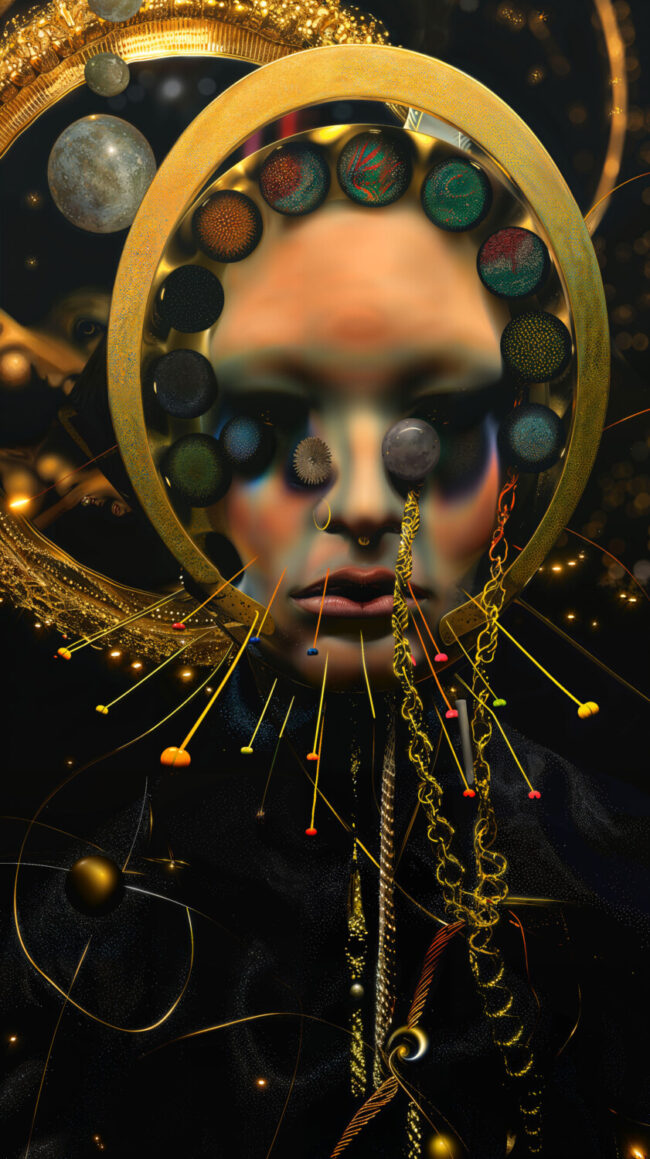
Tù.úk’z / Carcosa / Wooden Panel / UV print
Jenni Pasanen is another artist who deeply explores the possibilities of AI in art, utilizing mixed media such as digital painting, photography, and AI tools. Focusing on body parts like eyes and hands, she creates fantastical and emotional works. Her twin pieces “Live on” and “No Evil” were created using Artbreeder splicer and Stable Diffusion, combining AI-generated images with digital painting based on models trained on her own artwork. The flowing colors from the body merge with the abstract background, embodying a narrative shrouded in fantasy. The repetitive touch in her works blurs the boundary between machine and human, raising the question of where the artist’s touch begins and the machine’s input ends, illuminating this invisible boundary.
The co-creation of AI and humans is set to transform art. By integrating AI into their processes, artists can explore new creative realms previously unreachable. AI acts as a collaborator, offering unique perspectives and generating surprising results that inspire artists to think differently. This relationship allows for a deeper exploration of themes like identity, originality, and creativity. –Jenni Pasanen
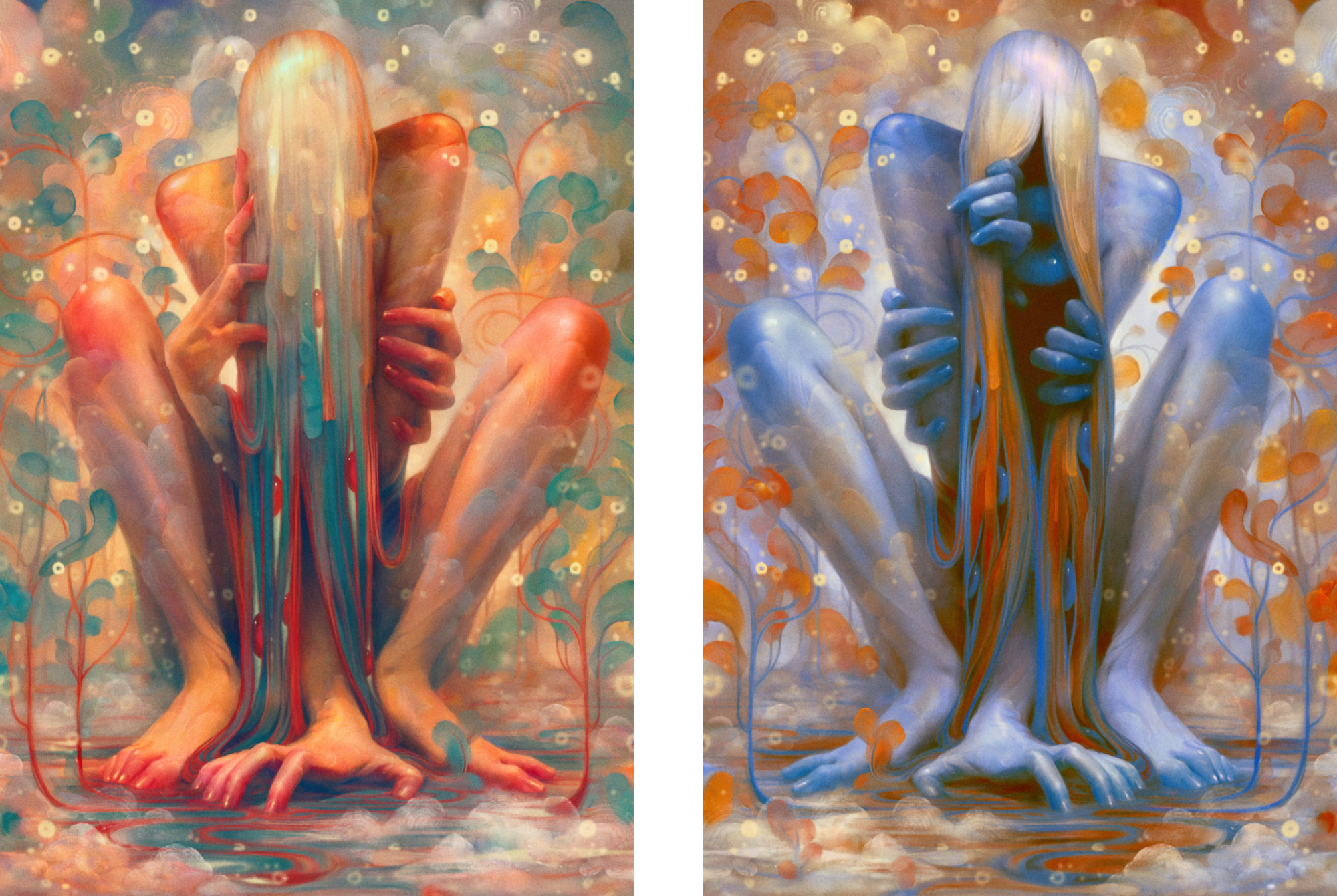
Jenni Pasanen / Live on / Wooden Panel / UV print
Jenni Pasanen / No Evil / Wooden Panel / UV print
Nic Hamilton, a Melbourne-based graphic designer and artist with a background in architecture, creates multi-layered meanings through the combination of different materials and media. His exhibited work, “Liffey (Timeframe),” explores themes such as the passage of time, the intersection of nature and the artificial, and the processes of creation and destruction. By merging elements from different dimensions, his work fosters a visual dialogue, encouraging the viewer to interpret it from multiple angles.
AI for me is a database, it is not conscious, its not that remarkable beyond the initial novelty of expediting ideation. I see it as a lossy and comprehensive excel document to make artwork with while introducing a degree of unexpected input. —Nic Hamilton
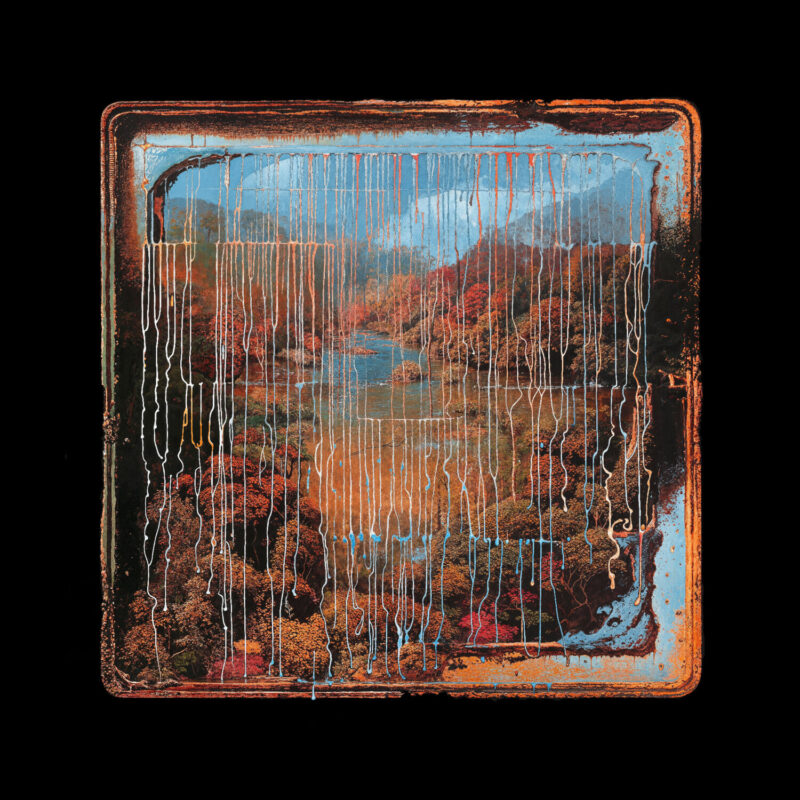
Nic Hamilton / Liffey (Timeframe) / Wooden Panel / UV print
Studio Brasch, also known as Anders Brasch-Willumsen, has created many works inspired by Japanese culture. Using 3D and more recently AI as mediums, he creates artistic inquiries and depicts imaginative worlds. His work “Yohaku” reinterprets the traditional still life subject of flowers, a long-standing motif in art, through delicate textures and intense colors, portraying a phantom image of flowers with abstract and fluid brushstrokes.
This series began as a series of expressive, painted strokes. I then took these strokes and trained an AI on them, alongside images from all my floral art projects of the past. This created an interesting combination, creating results that stretched far beyond what I could have imagined on my own, and yet, the very fabric of these artworks came from my own hand, from my literal signature. Flowers in art, and in painting and photography in particluar, is what the chair is to a furniture designer: a subject that has been used extensively. And strokes, to me, speaks to the foundation of an artwork, traditionally speaking.These were important artistic decisions as I wanted to get back to the basics of art, and thereby leaning into the notion that AI is about to change not just art but our very existence as we know it.
—Studio Brasch
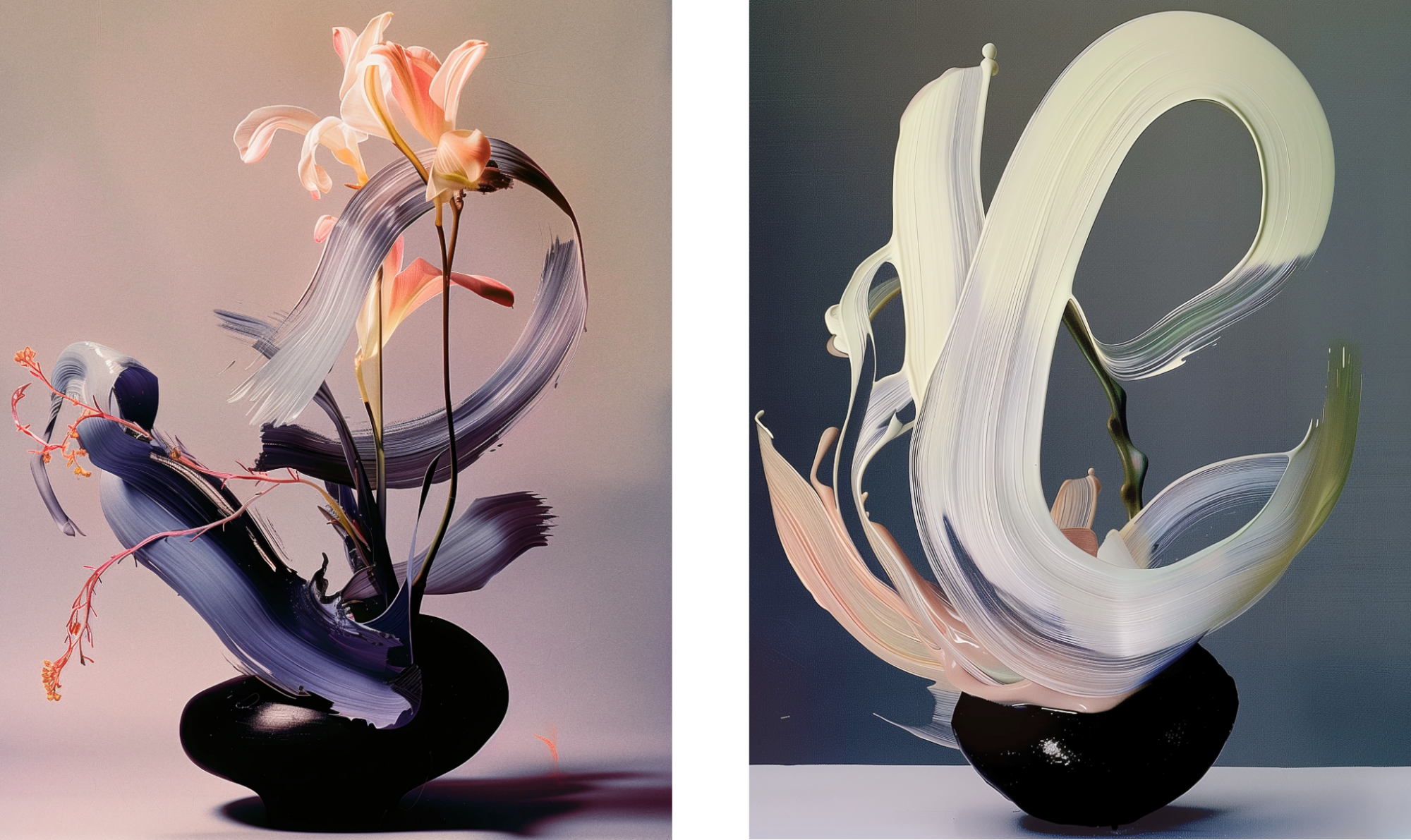
Studio Brasch/ Yohaku / Wooden Panel / UV print
Felipe Filgueiras is a Brazilian artist who creates psychedelic worlds of imagination. His works, like visual narratives, possess multiple layers and dimensions, blending elements from the natural and supernatural worlds to blur the boundary between reality and unreality. Using blindingly vivid colors and organic forms, he creates a fantastic universe where different elements intersect in a visually striking and meticulously detailed manner.
Work made with AI collage, digital painting, and generative imaging. Blending togheter to create a small microverse of existance of the self. Like many of my works, this piece explores the concept of a NEON paracosm, where your inner self glistens like a multicolored flora of chromatic euphoria. —Felipe Filgueiras
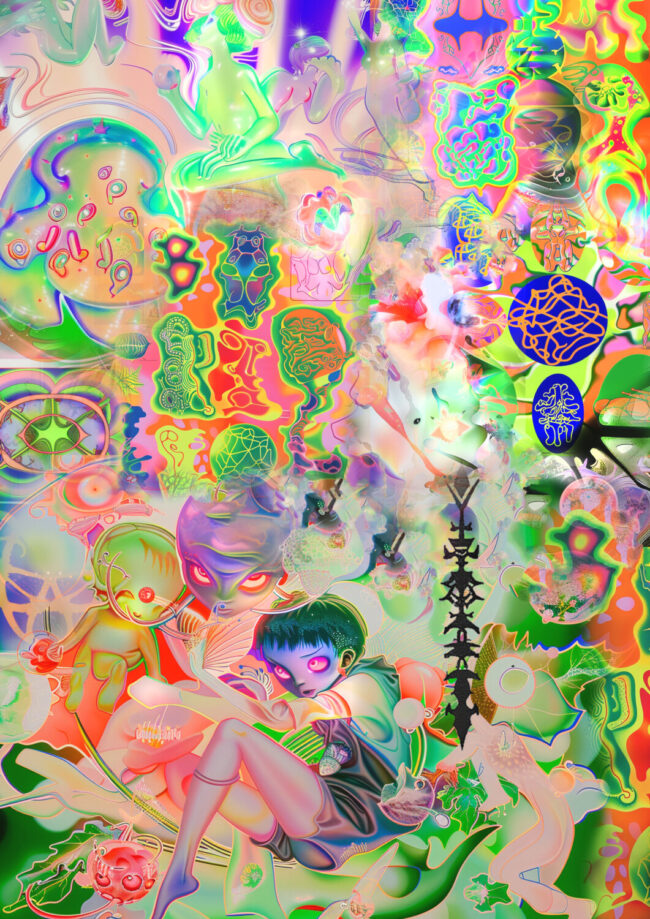
A Brief History of AI Art
To better understand the concept behind this exhibition, let’s take a brief look back at the history of AI art. A significant milestone was the introduction of Generative Adversarial Networks (GANs) by Ian J. Goodfellow in 2014. This technology, which marked a turning point in AI art, significantly improved the ability to generate realistic images and had a profound impact on the development of AI art. Since then, numerous technologies derived from GANs have emerged. These include StyleGAN, which can generate highly realistic images of faces and other complex subjects, and CycleGAN, which can convert images from one style to another. These advancements have expanded the potential applications of creative AI.
In 2018, the first AI-generated artwork was auctioned at Christie’s. The portrait “Edmond de Belamy,” created by the Paris-based artist group Obvious using GAN and an art database from WikiArt, sold for approximately $430,000, sending shockwaves through the art world. This event marked the establishment of AI art in the art market.
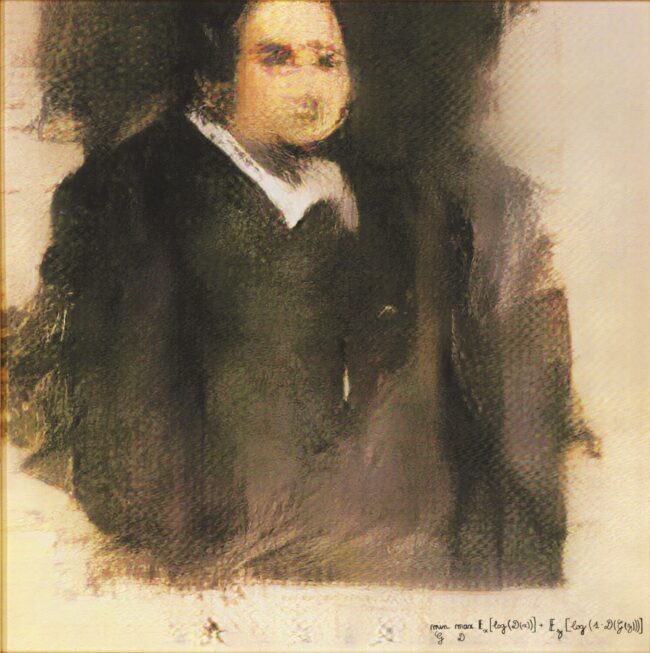
Obvious / Edmond de Belamy
In the same year, one of the pioneers of AI art, Mario Klingemann, unveiled his work “Neural Glitch / Mistaken Identity.” In this piece, trained GANs were randomly altered, deleted, or replaced, introducing glitches into the model, which led the machine to make incorrect interpretations. Another artist and researcher, Anna Ridler, used GANs in her work “Mosaic Virus,” where the patterns and colors of tulips changed in sync with Bitcoin price fluctuations, reflecting on the history of speculation and its connection to the economy. In 2019, Refik Anadol, known for his large-scale exhibitions at MoMA and elsewhere, also debuted his AI-based work. His breakthrough piece, “Machine Hallucination,” applied machine learning algorithms to over 100 million photographic memories of New York City posted on social media, visualizing the city’s collective memory. He refers to his series of AI works as “AI Data Paintings” and “AI Data Sculptures.”
Anna Ridler – Mosaic Virus from m-cult
Unsupervised – MoMA – NFT Colletion Teaser from Refik Anadol
Another milestone in the advancement of AI art was the emergence of AI models that generate images from prompts. The introduction of models such as Midjourney, DALL-E 2, and Stable Diffusion further accelerated the flow of AI art. These models can efficiently generate images with fine details and high resolution, and their ability to create high-quality images from text-based inputs has encouraged many artists to dive into AI art.
One such AI artist is Claire Silver, who creates unique artworks using text-based prompts. Her works have expanded the possibilities of dynamic interaction and collaboration between the AI’s interpretation and the artist’s intent. The intersection of AI and photography, known as post-photography, is also rapidly developing as an area of interest in contemporary art. For example, Emi Kusano continues to generate images of fashion snaps from a parallel world, representing her deep affection for Japanese fashion culture. Her works express the state of modern people living in a post-truth era, where the boundaries between reality and fiction are increasingly blurred. Post-photography offers diverse perspectives on reality while raising questions about what constitutes a photograph. It can become a new form of expression that transcends the mere documentation of reality by not relying on a camera.
Conclusion
The advent of creative systems that integrate machines and humans, represented by generative AI, has the potential to fundamentally alter our cultural landscape. While these systems may complement and expand human creativity, opening up creative expression and education to many people, the rapid spread of this technology could also alter the nature of authorship and originality in art, and may even undermine the value of craftsmanship. As technology envelops the world on a global scale, reshaping the very environment we live in, it is becoming an urgent task to reflect on the relationship between humans and technology. Should we not, then, question the significance of the emergence of this new form of intelligence?
